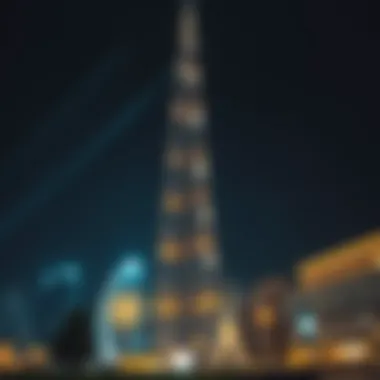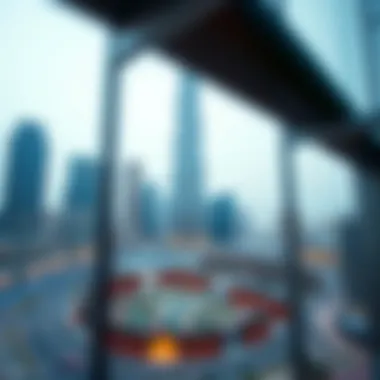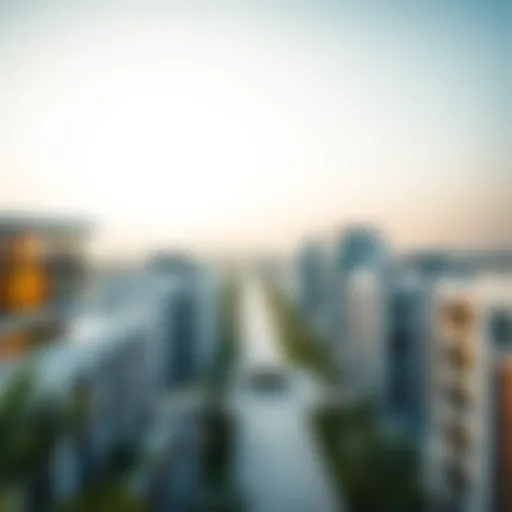Exploring the Height of Burj Khalifa in Detail


Intro
The Burj Khalifa stands as a monumental testament to human ingenuity and ambition. Nestled in the heart of Dubai, this colossal structure is not just about height, it symbolizes the soaring aspirations of a city that has transformed from a humble fishing village into a global hub for business and leisure. But understanding the height of Burj Khalifa goes far beyond merely measuring its 828 meters from base to tip. It invites an exploration of the architectural brilliance involved in its construction, the cultural implications that accompany such an iconic landmark, and its far-reaching influence on Dubai’s property market.
Architectural Feats
Designed by the famed architecture firm Skidmore, Owings & Merrill, the Burj Khalifa incorporates innovative engineering techniques to achieve its impressive stature. The building features a blended wing structure, akin to a desert flower, which reduces the effects of wind forces and allows for increased stability at extreme heights. The spire contributes significantly to its towering presence, creating an unmistakable silhouette against the sky.
Consider also the advanced materials used. Reinforced concrete was employed for its core, a decision made for both safety and sustainability, ensuring the building could withstand the harsh desert conditions and seismic activity. This synergy of design and material is essential to conceptualizing not just how tall Burj Khalifa is, but the countless meticulous decisions behind that height.
Market Insights
Current Trends in Dubai Real Estate
The real estate landscape in Dubai is constantly evolving. Since the completion of Burj Khalifa in 2010, the properties near this architectural giant have seen an upswing in desirability. High-end apartments and luxury developments in the vicinity have drawn a diverse mix of local and international investors. The demand, spurred by increasing tourism and a vibrant economy, has made Dubai one of the top choices for expatriates looking for a new home.
- Luxury Living: High-rise apartments near the Burj Khalifa command premium prices, given their prestigious location.
- Commercial Boom: The impact of Burj Khalifa isn't limited to residential areas; businesses seek office spaces that promise prestige and visibility.
The continued influx of expatriates and escalating tourism numbers shine a positive light on the potential for growth in the property market.
Predicted Market Growth and Future Opportunities
Market analysts feel optimistic about the future of Dubai's real estate market due to various factors: increased government support for real estate initiatives, and an expanding local economy focused on diversification. Furthermore, the upcoming events in Dubai, including the World Expo and ongoing infrastructural developments, promise to drive further interest and investments.
Housing experts highlight
- Sustainable Projects: An upward trend towards eco-friendly buildings that comply with international green standards.
- Smart Home Integration: A notable inclination towards smart technologies as homebuyers seek efficiency and connectivity.
"Investors looking at Dubai are not just seeing structures, they are observing a city that evolves and embraces new trends constantly."
With the right strategies, those entering Dubai’s property market stand to gain immensely from the current momentum.
Investment Strategies
Tips for First-Time Buyers
Navigating the bustling real estate landscape can seem daunting for first-time buyers.
- Research Thoroughly: Understand local regulations and market conditions before diving in.
- Location: Focus on properties close to Burj Khalifa for higher potential returns.
- Consult Professionals: Engage with local real estate agents who have an in-depth grasp of the market.
Analyzing High-Potential Investment Areas
Investors should keep an eye on upcoming neighborhoods around the Burj Khalifa.
- Business Bay: An emerging business hub with many developments reaching completion.
- Downtown Dubai: Continues to attract affluent clientele; property prices here typically appreciate well over time.
By ensuring a keen understanding of these areas combined with solid investment strategies, an investor can find themselves a valuable asset in Dubai's thriving property market.
For more information on investing in Dubai’s real estate, consider visiting resources such as [Dubai Land Department](https://www.duba Land.gov), Arabian Business, and Property Finder.
Understanding the height of Burj Khalifa isn't just about its measurement; it's about realizing how it reshapes the skyline, instills cultural pride, and propels an ever-growing real estate market.
Prelude to Burj Khalifa
The Burj Khalifa stands as an emblem of modern engineering and design, tracing its roots back to a vision that sought to redefine the very concept of height in the architectural landscape. Not just a structure, it's a narrative woven into the fabric of Dubai's identity, embodying ambition, innovation, and cultural significance.


Delving into the Burj Khalifa offers a multidimensional perspective. First and foremost, it serves as a critical landmark for investors, homebuyers, and expatriates seeking opportunities in one of the most vibrant property markets globally. Understanding its height, both technically and socioculturally, allows us to grasp the monumental role it plays in shaping Dubai's image as a global hub.
Additionally, this section introduces two pivotal themes: the historical context that led to the building's conception and its architectural marvel, which resonates with a wide array of audiences. By unraveling the story behind this magnificent structure, we not only appreciate the physics of its height but also the heart that beats within the walls of this skyscraper—revealing layers of investment potential, historical resonance, and artistic creativity.
Historical Context
To appreciate the Burj Khalifa’s stature fully, one must consider the dirt path that brought it to life. Initiated during the economic boom of the early 2000s, the project was geared to symbolize the progressive aspirations of Dubai and the United Arab Emirates at large. The idea was born from a compelling need to diversify the economy away from oil dependency, a sentiment echoed across the government’s vision that champions tourism and real estate as catalysts for growth.
Planned in 2004 and completed in 2010, the Burj Khalifa originally bore the name "Burj Dubai." This name change reflected not just the completion of the tower but also a renewed sense of identity tied to the rulers and the people. The historical moment came during the global financial crisis, which posed challenges but also momentarily paused the world’s awe as they watched how Dubai would bounce back with a defining architectural statement.
Architectural Marvel
The sheer height of the Burj Khalifa is one of its most apparent features, but its architectural significance goes far beyond mere numbers. Reaching a staggering 828 meters, the building holds the title of the tallest structure in the world, employing design principles that harmonize aesthetics and function. Designed by Adrian Smith of Skidmore, Owings & Merrill, the tower mimics the shape of a desert flower, creating a harmonious blend between the environment and the structure itself.
Key Architectural Features:
- Triangular Floor Plan: This design maximizes structural stability while allowing for sweeping views.
- Y-shaped Layout: This unique shape helps reduce wind forces against the structure, making it one of the safest buildings to inhabit.
- Observation Deck: Located on the 148th floor, it provides an unparalleled perspective of Dubai’s skyline; a nod to the building’s purpose as a tourist destination.
As investors contemplate property decisions in the vicinity, they must also consider how Burj Khalifa continues to influence the urban fabric of Dubai. In observing its architectural brilliance, we see a bold statement of purpose and potential, beckoning those who aspire to partake in this rapidly expanding property market. Visiting or investing within this architectural wonder is not merely about height; it’s about immersing oneself into a living testament of visionary planning and execution.
"The Burj Khalifa is more than just a building—it is a revolution of ambitious dreams and transformative design that reshaped the desert landscape."
In summary, by exploring the Burj Khalifa’s introduction, its historical context, and architectural marvel, we set the stage to understand the multiple dimensions of its height. Each facet offers insights that go beyond architectural specifications to explore its formidable influence on Dubai’s identity and its real estate sector.
The Height of Burj Khalifa
The towering presence of Burj Khalifa rises prominently in Dubai’s skyline and serves as a testament to human ingenuity and ambition. Understanding the height of this architectural dream is not merely number crunching; it encapsulates the very essence of engineering prowess and aesthetic expression. This section breaks down not only the official height of Burj Khalifa but also pits it against other giants in the vertical landscape, highlighting its supremacy and architectural significance.
Official Height Measurement
The official height of Burj Khalifa is a staggering 828 meters, or about 2,717 feet, from its base to the tip of its spire. This measurement considers the varying elements of the structure, including its foundation and the distinctive spire. To differentiate, the height is often measured in two distinct ways: the architectural height, which includes spires, and the total height with antennas. Such precise measurements required advanced technologies, such as tools for seismic gauging and laser measurements.
It’s crucial to note that when discussing the height of Burj Khalifa, we cannot overlook the foundational work that supports it. The construction process involved digging deep into the Dubai soil to lay a robust foundation, essential for such a towering structure. Thus, when defining its height, all intricate calculations of structural and geological engineering are at play here, ensuring it stands tall and unwavering amidst the desert winds.
"The Burj Khalifa's height is a bold stroke in the canvas of Dubai's skyline, redefining boundaries between earth and sky."
Comparison with Other Tall Structures
In the realm of skyscrapers, Burj Khalifa reigns supreme. To put its height into perspective:
- Shanghai Tower (China): Standing at 632 meters, it is the second tallest building in the world, and yet, it falls short by 196 meters when compared to Burj Khalifa.
- Abraj Al Bait Clock Tower (Saudi Arabia): This clock tower reaches 601 meters, showcasing the architectural diversity across the Middle East, but again it doesn’t quite match the heights reached by Burj Khalifa.
- One World Trade Center (USA): At 541 meters, it symbolizes resilience and hope following tragedy, but still, it’s dwarfed by Burj Khalifa's impressive stature.
This leads to discussions about what these measurements mean in relation to urban design and cultural symbolism. Each building reflects not just its height but what it represents for its home city—a statement of ambition, innovation, and pride. Understanding Burj Khalifa in conjunction with its contemporaries sheds light on the competitive spirit of global cities striving for supremacy in the skyline.
In summary, the height of Burj Khalifa is not just a metric; it is a narrative of aspiration, creativity, and the spirit of Dubai—a leaning tower of modern civilization that continues to inspire future architectural endeavors.
Construction Aspects
The construction aspects of Burj Khalifa are not just a testament to engineering prowess; they reveal the complexities of creating a structure that stands as a beacon of ambition and innovation. Understanding these elements sheds light on how such an extraordinary height was achieved and the implications for future architectural endeavors. This section delves into the engineering challenges faced during construction and the specific materials that were utilized, both of which significantly influenced the building’s structural integrity and overall aesthetic.
Engineering Challenges
Building the tallest skyscraper in the world was anything but a walk in the park. Various engineering challenges arose during the project’s inception and completion, notably due to the staggering height of the Burj Khalifa. One primary obstacle was managing the intense wind forces at such altitudes. Designers had to develop cutting-edge solutions to ensure structural stability against high winds. This involved sophisticated wind tunnel testing and the incorporation of a unique, dynamic design that allows it to sway without compromising safety.
Moreover, the foundation posed its own set of challenges. The Burj Khalifa rests on a complex mix of soil and rock, necessitating an exceptionally robust base. Engineers used a deep foundation system known as a raft foundation, which is anchored by hundreds of piles that extend deep into the ground. These adaptations exemplify the necessity of innovative engineering when tasked with a structure of this magnitude.
"Innovation is key in skyscraper construction—every project presents unique hurdles that forge paths toward a better understanding of architecture."


Materials Used in Construction
The selection of materials for the Burj Khalifa wasn't your run-of-the-mill choice. Every component chosen played a vital role in maintaining the building's massive stature while ensuring durability and elegance. Around 103,000 square meters of glass were employed, carefully selected for thermal performance and aesthetic appeal. This vast facade allows natural light to flood the interiors while minimizing solar heat gain, hence promoting energy efficiency.
In terms of concrete, the Burj Khalifa utilized a specialized high-performance concrete mix that can withstand extreme tensions and pressures. With a compressive strength of over 80 megapascals, this concrete allowed the team to build higher than ever before. Steel reinforcements added further resilience, with approximately 39,000 tons of steel utilized throughout the structure.
The use of these materials came with rigorous inspection and testing processes to ensure safety and reliability.
In summary, the construction aspects of Burj Khalifa tell a tale of innovation, resilience, and precision. It's a profound mix of challenges overcome through engineering brilliance and the strategic use of cutting-edge materials. By taking a closer look, both investors and architects alike can glean insights not only into this incredible structure but also into the future of skyscraper design.
Burj Khalifa's Role in Dubai's Identity
The Burj Khalifa is not merely a structure; it is the beating heart of Dubai's identity. Nowhere in the city do you see a physical embodiment of ambition, wealth, and innovation quite like this towering marvel. More than just the tallest building in the world, it serves multiple roles that resonate deeply with the culture, economy, and psyche of the city. Here’s a closer look at how the Burj Khalifa plays this multifaceted role in shaping Dubai’s identity.
Cultural Significance
The cultural impact of the Burj Khalifa is genuinely profound. Erected amidst the desert landscape, the building reflects the aspirations of the Emirati people. It's not just a tall building; it stands as a reminder of the rich heritage that feeds into modern achievements. Local artists and architects often draw inspiration from its distinctive design, which harmoniously blends contemporary aesthetics with traditional elements from Islamic architecture.
Moreover, the Burj Khalifa plays a crucial role in various cultural celebrations. During special occasions like New Year's Eve, the tower becomes a canvas for spectacular light displays that draw crowds from all corners of the globe. Such events encapsulate the spirit of togetherness in the community, elevating its status from a mere architectural feat to an emblem of cultural pride.
Tourist Attraction
Visitors flock to Dubai, drawn by its exotic allure, and at the heart of this attraction is the Burj Khalifa. Tourists are not just interested in ascending its heights for the breathtaking views; they are also enamored by the experience itself. The opportunity to step into the At the Top observation deck offers an unrivaled panorama of the sprawling city and beyond, enticing around 1.5 million visitors annually.
Many tour packages beautifully tie in visits to the Burj with explorations of nearby attractions such as the Dubai Mall, where the shopping experience is equally remarkable. The tower thus becomes a pivotal part of a larger tourism framework that contributes significantly to the UAE's economy. With elements like the Dubai Fountain at its base, the overall experience is curated to leave visitors enthralled.
Symbol of Progress
When one thinks of progress, the Burj Khalifa is unavoidably at the forefront of that conversation. The building epitomizes what the modern UAE strives for—growth marked by opulence and ingenuity. It symbolizes the remarkable transformation from a modest fishing town to a global nexus of commerce and culture within just a few decades.
Many analysts view the Burj Khalifa as more than just an engineering triumph; they see it as a global statement. It signifies that Dubai is not just keeping pace with world standards, but setting them. Investor confidence has surged since its construction; when the Burj Khalifa was completed in 2010, it sparked a wave of real estate development in its vicinity, further illustrating how a single structure can ignite broader economic advancements.
"The Burj Khalifa does not just scrape the sky; it touches the very soul of progress itself."
Impact on Real Estate Market
The Burj Khalifa isn't just a towering edifice; its impact ripples through Dubai's real estate landscape like a stone cast into a still pond. When one considers a property investment within the city, the presence of this architectural titan weighs heavily on desirability and property values. The Burj Khalifa serves not merely as a symbol of opulence but also as a significant driver of economic activity in the surrounding area. Its influence on property values and investment prospects cannot be overlooked.
Influence on Property Values
The mere mention of the Burj Khalifa instantly elevates nearby properties in the eyes of prospective buyers and investors. The iconic structure has become synonymous with luxury, leading to heightened demand for real estate in its vicinity. Properties located within a short distance of the Burj enjoy a favorable position in the market, often commanding premium prices.
Consider the following points regarding its influence on property values:
- Prestige Factor: Owning a property near such a landmark bestows a sense of prestige on the owner. This perception alone inflates both rental and sales prices.
- Economic Activities: The bustling environment around the Burj Khalifa includes high-end shops, fine dining establishments, and entertainment venues. Such amenities inherently boost property attractiveness.
- Stable Investments: Generally, properties near iconic landmarks are less susceptible to market fluctuations, thus acting as stable investments for long-term holders.
The results are plain as day: real estate agents often see quicker sales and increased offers for homes near this striking skyscraper. Investors recognize a sound investment as properties consistently appreciate in value due to the Burj Khalifa's presence.
Investment Opportunities in its Vicinity
The Burj Khalifa is a beacon for investors looking for lucrative opportunities. The surrounding area offers multiple pathways for both residential and commercial investments. With Dubai's real estate sector continually evolving, the vicinity of the Burj is particularly ripe for development. Here are a few compelling investment prospects:
- Residential Developments: Numerous residential complexes have sprouted within walking distance of the Burj, catering to a diverse demographic. From luxury apartments to more economical options, this area meets the needs of various investors.
- Commercial Properties: The demand for office spaces nearby is on the rise. Businesses consider proximity to the Burj a desirable factor for attracting clients and talent alike.
- Hospitality Ventures: Tourism flourishes around the Burj Khalifa, thus hospitality investments, like hotels and serviced apartments, can reap generous rewards.
- Retail Opportunities: With the huge foot traffic generated by visitors, retail spaces near the Burj are hot commodities. Investment in retail can yield high returns in terms of revenue.
"Investing in real estate around iconic structures like the Burj Khalifa is akin to planting a tree with deep roots. It may take time to grow, but the returns will be fruitful for those who are patient."
In summary, the Burj Khalifa is not only an architectural wonder; it is a prominent factor in Dubai’s real estate market. From direct monetary impacts on property values to a plethora of investment avenues, the implications of this skyscraper stretch far and wide. For investors, homebuyers, or anyone interested in navigating Dubai’s property scene, the Burj Khalifa’s surrounding area represents a unique opportunity waiting to be explored.


Technological Integration
The Burj Khalifa stands as more than just a remarkable height; it embodies a cutting-edge approach to modern architecture and engineering. Technological integration plays a crucial role in maximizing functionality and ensuring the longevity of this monumental structure. This section delves into two vital components of technological innovation within the Burj Khalifa: smart building features and sustainability efforts.
Smart Building Features
The Burj Khalifa is outfitted with an array of smart building technologies that enhance comfort, security, and efficiency. One notable feature is the use of a Building Management System (BMS) that helps in monitoring and controlling various functionalities of the building. This system encompasses climate control, lighting, and security systems, all tailored to optimize energy use and operational performance.
The elevators in the Burj Khalifa are also a marvel in their own right. They utilize advanced algorithms to determine the most efficient route for users, significantly reducing wait times and energy consumption. The double-decker elevators can serve multiple floors at once, further enhancing the overall efficiency of the building.
Additionally, there are automatic systems in place for fire and safety management, integrating alarms and emergency responses to ensure swift action in case of any incidents. This smart integration reflects the Burj Khalifa's commitment to creating a safe environment for its residents and visitors alike.
Sustainability Efforts
Sustainability is a pressing concern in contemporary architecture, and in this respect, the Burj Khalifa excels. Emphasizing energy efficiency, the building incorporates a variety of sustainable practices. For instance, it features a special glass that minimizes heat gain while providing ample daylight inside. This reduces reliance on artificial lighting and lowers energy costs significantly.
Another aspect of its sustainability efforts is the use of a water recycling system that collects and treats wastewater. This water is then reused for irrigation and other non-potable purposes, reflecting a commitment to responsible resource management. The strategic landscaping around the building has also been designed to minimize water use while enhancing aesthetics.
"Modern skyscrapers like the Burj Khalifa are not just about reaching new heights; they serve as benchmarks for how technology can redefine our urban landscapes."
Incorporating these innovative technologies not only showcases the engineering prowess behind the Burj Khalifa but also sets a precedent for future skyscrapers. Investors and homebuyers alike should consider these features as not just amplifying the building's stature but as essential elements in the evolving landscape of urban development.
Public Perception
Public perception is vital to understanding the Burj Khalifa's significance not just as an architectural feat but also as a cultural and economic symbol of Dubai. This multifaceted structure shapes how both locals and international observers view the emirate and its aspirations. As a towering presence, the Burj Khalifa fosters a strong sense of pride among residents, often evoking a feeling of belonging. Conversely, its global recognition helps to position Dubai as a major player on the world stage. The discussion around public perception can be broken down into local sentiments and global attitudes, each influencing the narrative around this iconic structure.
Local Response
The local response to the Burj Khalifa is one of awe and admiration. The building is described by many as a source of national pride. For residents, the Burj Khalifa represents a blend of tradition and modernity, a physical metaphor for Dubai's rapid development.
Many Emiratis appreciate how the structure embodies Emirati architectural ingenuity while also respecting local customs. Across various social media platforms, discussions frequently highlight its role in community gatherings and celebrations. Furthermore, the local populace often engages in events hosted at the Burj or near its base, including annual fireworks displays on New Year’s Eve, which become a communal experience.
- Increased tourism: In the eyes of locals, the Burj has become a magnet for tourists, boosting the economy and creating jobs.
- Civic pride: Residents frequently share photos of the Burj Khalifa, contributing to a collective sense of belonging.
In addition, the Burj Khalifa has sparked interest in the younger generation, inspiring future architects and engineers. As locals see the ongoing developments and projects inspired by the Burj, they become eager to contribute to Dubai's growing skyline.
Global Recognition
On the global stage, the Burj Khalifa is more than just a building; it’s a symbol of what modern engineering and design can achieve. Various international awards validate its architectural excellence, elevating its status even further.
Burj Khalifa regularly appears in global media, whether in documentaries, travel features, or architectural discussions. This consistent presence ensures that the building is often top-of-mind in various contexts, reinforcing Dubai's image as a city of innovation and luxury.
"Burj Khalifa is not just the tallest building; it’s a statement that innovative design can lead to economic growth and cultural identity."
- Cultural exchange: Visitors from around the world often express their appreciation for the Burj, facilitating global conversations about architecture.
- Influence on real estate: Its prominence influences international investors seeking properties in Dubai, showcasing how one structure can impact a city’s real estate market.
Promotional efforts, including the use of influencer marketing and targeted campaigns, aim to attract tourists and investors alike. Through high-profile partnerships and events, Dubai continually reinforces the Burj Khalifa's importance on a global platform.
For more information about architectural landmarks, you can visit Wikipedia or Britannica.
Epilogue
In summarizing the vast exploration of Burj Khalifa's unique stature, it becomes clear that the significance of this towering masterpiece extends far beyond its height. The conclusion encapsulates key themes and insights that intertwine the architectural, cultural, and economic narratives of Dubai.
Addressing the future of Burj Khalifa, there is a palpable anticipation surrounding its role as a continuous symbol of innovation. How the building adapts to the shifting tides of urban development will be critical. This might mean introducing new technologies that ensure energy efficiency or perhaps reimagining the experience for visitors in an evolving landscape of skyscrapers. The approach Dubai takes—in regards to leveraging Burj Khalifa for its potential—will likely influence strategies for cities looking to assert their own identities on a global stage.
Moreover, the legacy of the world's tallest structure illustrates how architecture can anchor the essence of a city. As we navigate an increasingly interconnected world, Burj Khalifa stands as both a beacon and a blueprint, showcasing what is possible when ambition meets precise engineering. From being a vantage point that offers breathtaking views of the sprawling city to housing an array of luxury accommodations, the structure offers lessons in how monumental architectures can drive economic growth while fostering cultural pride.
Therefore, the future of Burj Khalifa isn't merely about maintaining its record-breaking height; it is about how it can continue to inspire, attract, and innovate while remaining firmly rooted in Dubai’s ever-changing fabric.
"The Burj Khalifa is not just a building; it's a significant part of Dubai's identity, echoing aspirations and achievements, now and for generations to come."
In summary, Burj Khalifa serves not only as an architectural wonder but as a defining element in the narrative of Dubai. As we reflect on its grandeur and significance, it is essential to recognize how it reshapes perceptions, motivates potential investors, and captivates tourists while leaving an indelible mark on the world of architecture and beyond.







